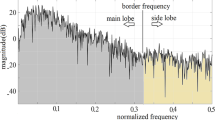Summary
Changes in electromyogram (EMG) power spectra were investigated in the triceps surae musclesof two classes of individuals (untrained subjects and athletes) maintaining a plantarflexion torque of 80% of maximal voluntary contraction until exhaustion. A set of 23 parameters describing changes in the frequency content and power of EMG was defined. For most experiments, classical changes were found, indicating a shift of the EMG spectra towards lower frequencies and an increase in the total power of the signals. In 12% of the experiments, alternations in activity between synergistic muscles were found, leading to a large variability in the spectral parameters. After the expression of each experiment in terms of a reduced data matrix and matrix to vector transformations, three methods of discrimination were used to classify subjects with respect to changes in the EMG signal during sustained contraction: (1) evaluation of the most discriminating parameter, (2) principal components analysis, (3) transformation maximizing differences between classes. Method (3) was found to be preferable since it led to good separation of the two classes in a reference group of subjects and a satisfactory projection of each individual from a group of unknowns into the appropriate class. These results suggest using a method such as this for ergonomic or athletic training purposes rather than the usual method of monitoring the frequency shift of the EMG.
Similar content being viewed by others
References
Bigland-Ritchie B, Donovan EF, Roussos CS (1981) Conduction velocity and EMG power spectrum changes in fatigue of sustained maximal efforts. J Appl Physiol Respir Environ Exerc Physiol 51:1300–1305
Clamann HP, Broecker KT (1979) Relation between force and fatigability of red and pale skeletal muscles in man. Am J Phys Med 58:70–85
DeLuca CJ (1984) Myoelectrical manifestations of localized muscular fatigue in humans. Crit Rev Biomed Eng 11:251–279
Draper NR, Smith H (1981) Applied regression analysis. Wiley, New York
Duchêne J (1983) Développement de méthodes de decision sur un ensemble de tableaux. Application au traitement d'électromyogrammes lors d'épreuves de fatigue. Thesis,Université de Technologie, Compiégne
Duchêne J (1986) A significant plane for two-classes discrimination problems. IEEE PAMI 8:557–560
Foley DH, Sammon JW (1975) An optimal set of discriminant vectors. IEEE Trans Comput C-24:281–289
Gollnick PD, Sjodin B, Karlsson J, Jansson E, Saltin B (1974) Human soleus muscle: a comparison of fiber composition and enzyme activities with other leg muscles. Pflugers Arch 348:247–255
Hagberg M (1981) Muscular endurance and surface electromyogram in isometric and dynamic exercise. J Appl Physiol Respir Environ Exerc Physiol 51:1–7
Hagberg M, Ericson BE (1982) Myoelectric power spectrum dependence on muscular contraction level of elbow flexors. Eur J Appl Physiol 48:147–156
Hagg G (1981) Electromyographic fatigue analysis based on the number of zero crossings. Pflugers Arch 391:78–80
Hof AL, van den Berg JW (1977) Linearity between the weighted sum of the EMGs of the human triceps surae and the total torque. J Biomech 10:529–539
Hujing PA, Adelerhof ASP, Giesbergen R, Woittiez RD, Rijnsburger WH (1986) Triceps surae EMG power spectrum changes during sustained submaximal isometric contractions at different muscle lengths. Electromyogr Clin Neurophysiol 26:181–192
Humphreys PW, Lind AR (1963) The blood flow through active and inactive muscles of the forearm during sustained hanggrip contractions. J Physiol (Lond) 166:120–131
IEEE (1971) Special issue on feature extraction and selection in pattern recognition. IEEE Trans Comput C-20:967–1117
Kadefors R, Petersen I, Herberts P (1976) Muscular reaction to welding work: an electromyographic investigation. Ergonomics 19:543–558
Komi PV, Tesch P (1979) EMG frequency spectrum, muscle structure and fatigue during dynamic contractions in man. Eur J Appl Physiol 42:41–50
Lago P, Jones NB (1977) Effect of motor-unit firing time statistics on EMG spectra. Med Biol Eng Comput 15:648–655
Lindstrom L, Magnusson R, Petersen I (1974) Muscle load influence on myoelectric signal characteristics. Scand J Rehabil Med [Suppl] 3:127–148
Lindstrom L, Kadefors R, Petersen I (1977) An electromyographic index for localized muscle fatigue. J Appl Physiol Respir Environ Exerc Physiol 43:750–754
Lippold OCJ, Redfearn JWT, Vuco J (1960) The electromyography of fatigue. Ergonomics 3:121–131
Moritani T, Muro M, Nagata A (1986) Intransmucular and surface electromyogram changes during muscle fatigue. J Appl Physiol 60:1179–1185
Mortimer JT, Magnusson R, Petersen I (1970) Conduction velocity in ischemic muscle: effect on EMG frequency spectrum. Am J Physiol 219:1324–1329
Petrofsky JS, Glaser RM, Phillips CA (1982) Evaluation of the amplitude and frequency components of the surface EMG as an index of muscle fatigue. Ergonomics 25:213–223
Roussos C, Fixley M, Gross D, Macklem PT (1979) Fatigue of inspiratory muscles and their synergic behavior. J Appl Physiol Respir Environ Exerc Physiol 46:897–904
Spath H (1980) Cluster analysis algorithms. Wiley, New York
Stulen FB, de Luca CJ (1981) Frequency parameters of the myoelectric signal as a measure of muscle conduction velocity. IEEE Trans Biomed Eng 28:515–523
van Boxtel A, Schomaker LRB (1984) Influence of motor unit firing statistics on the median frequency of the EMG power spectrum. Eur J Appl Physiol 52:207–213
van Boxtel A, Goudswaard P, Vander Molen GM, Vandenbosch WEJ (1983) Changes in electromyogram power spectra of facial and jaw-elevator muscles during fatigue. J Appl Physiol 54:51–58
Viitasalo JHT, Komi PV (1977) Signal characteristics of EMG during fatigue. Eur J Appl Physiol 37:111–121
Author information
Authors and Affiliations
Rights and permissions
About this article
Cite this article
Duchêne, J., Goubel, F. EMG spectral shift as an indicator of fatigability in an heterogeneous muscle group. Eur J Appl Physiol 61, 81–87 (1990). https://doi.org/10.1007/BF00236698
Accepted:
Issue Date:
DOI: https://doi.org/10.1007/BF00236698




